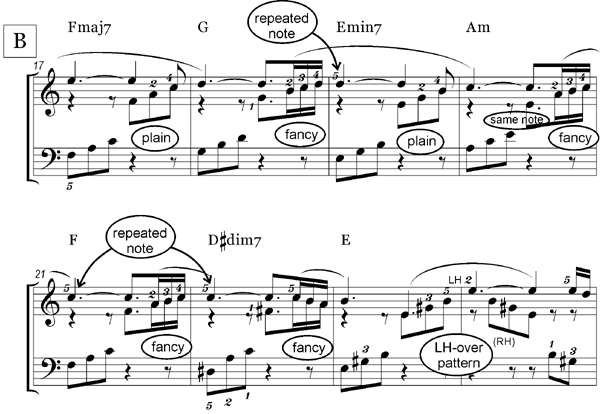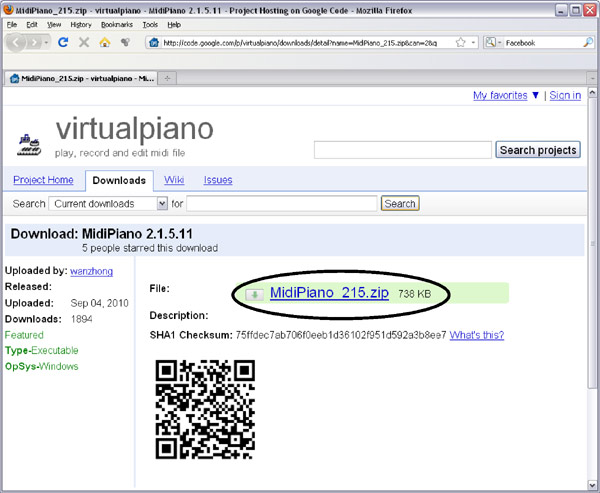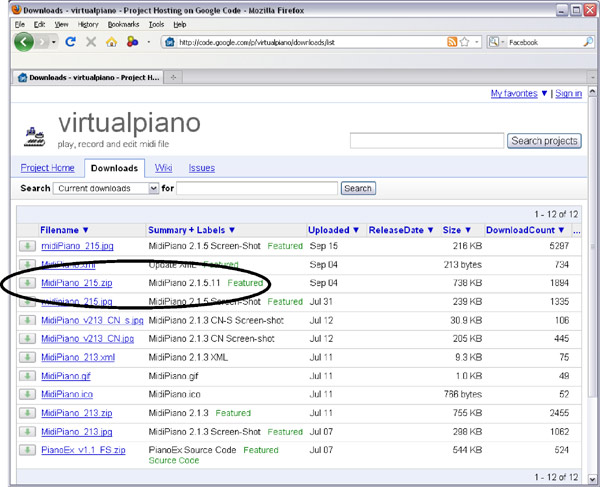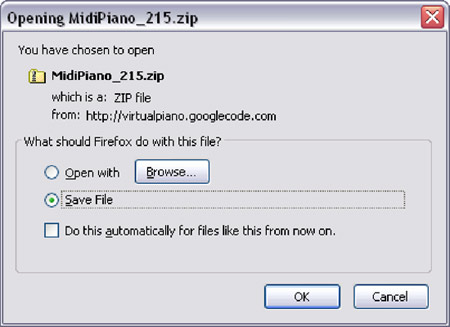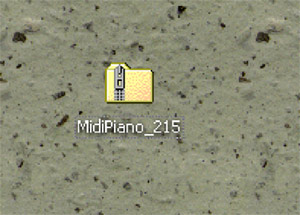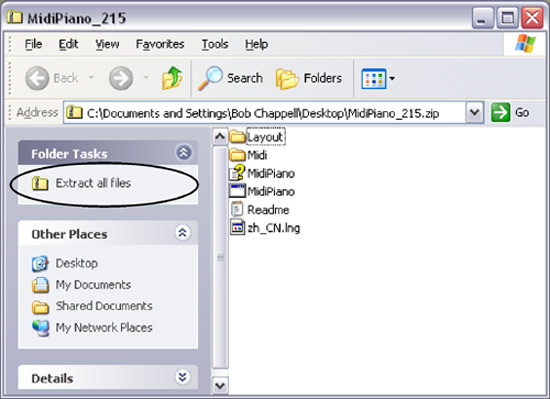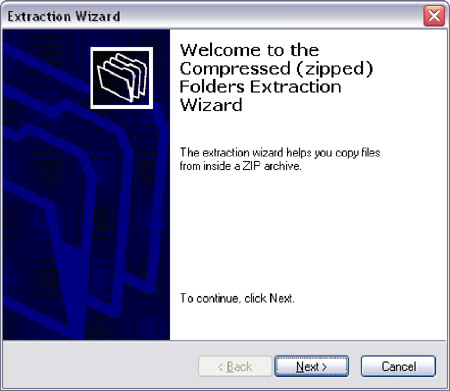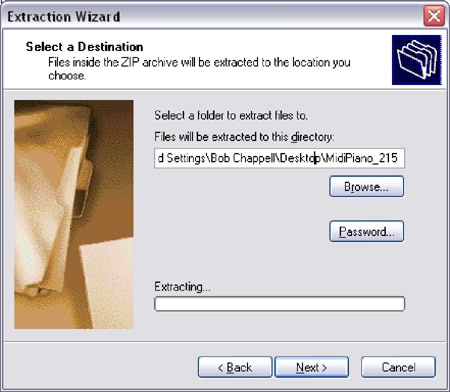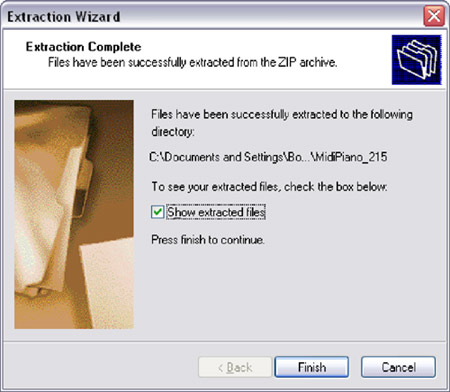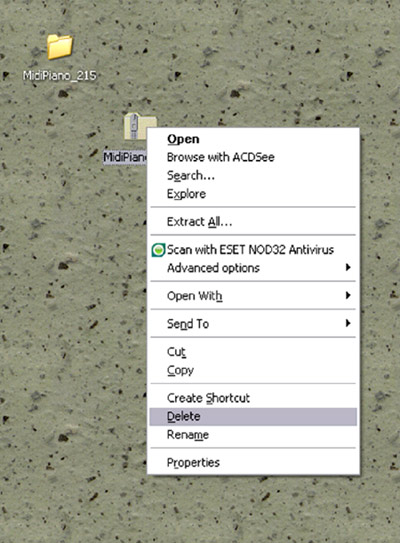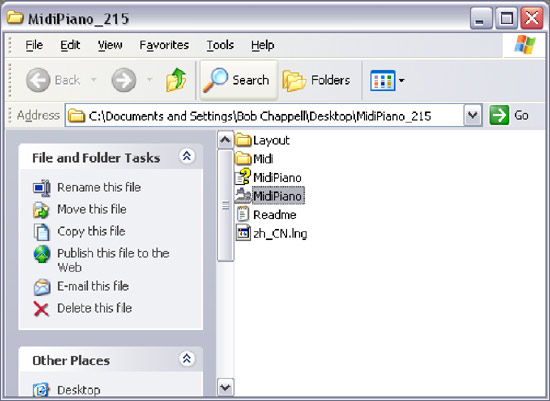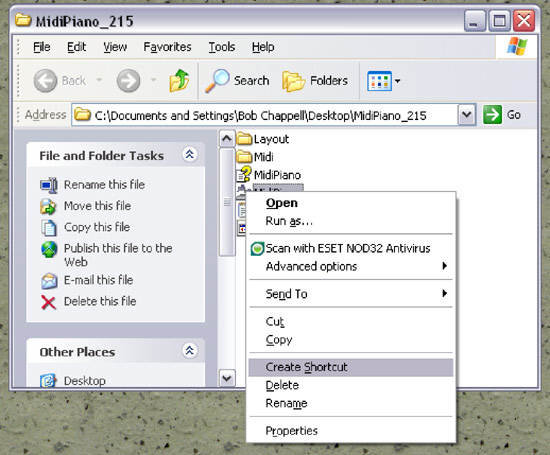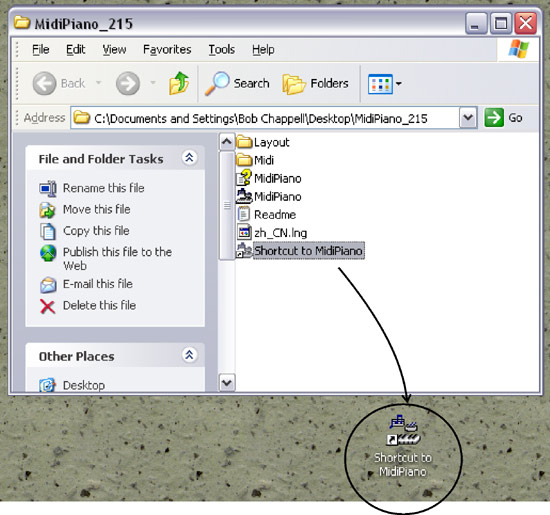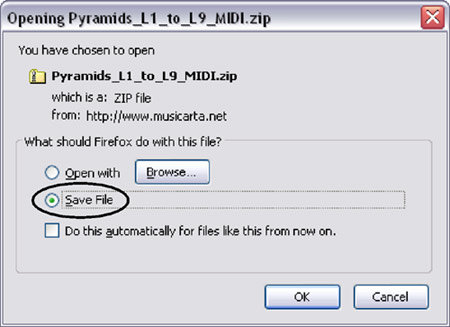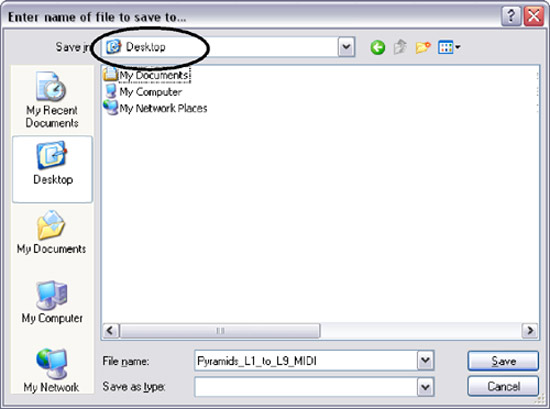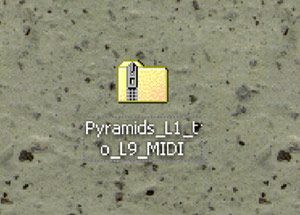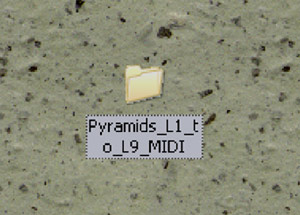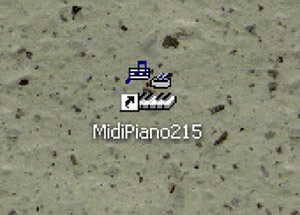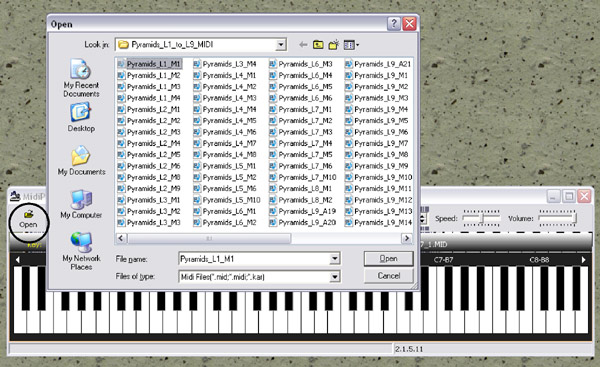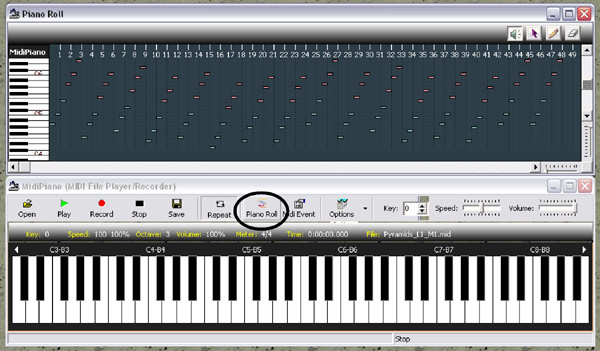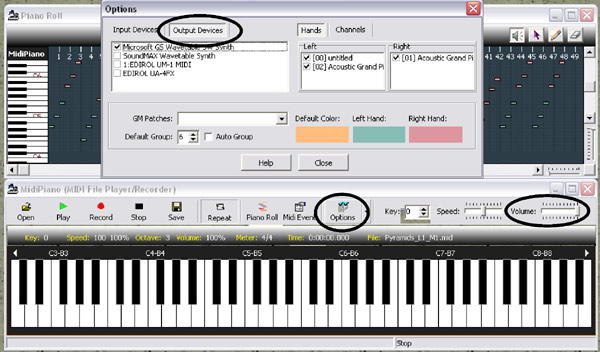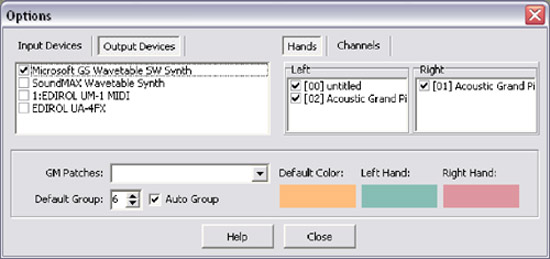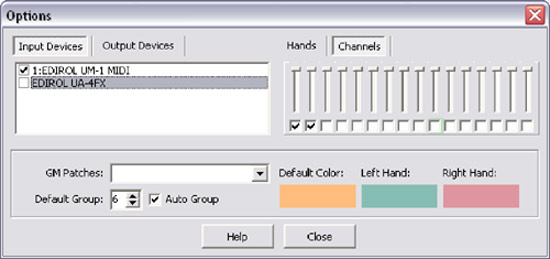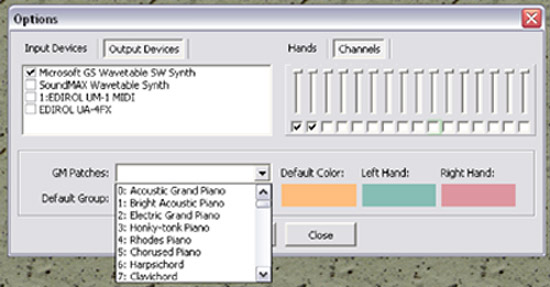| | MIDI Piano MusicMusicarta is introducing the option to download MIDI piano music files to accompany the site’s free online piano lessons – starting with The Pyramids Variations, Musicarta’s flagship lesson series.
MIDI, which stands for Musical Instrument Digital Interface, is the code computers use to read and write music. You can play MIDI files with many applications. Musicarta recommends that you download the free MidiPiano virtual keyboard for playing and viewing your MIDI piano music files. This page contains full instructions for downloading and using MidiPiano.
MidiPiano has a number of excellent educational features. As it plays a MIDI file, the piano keys used light up, colour-coded according to which hand is playing, while at the same time a useful and intuitive ‘Piano Roll view’ displays the music graphically.
The performance can also be slowed down to aid your study, and the hands individually muted. You can also record performances and save them as MIDI files, using MidiPiano as an introduction to MIDI sequencing.
Watch this short MidiPiano demonstration video
It shows a Musicarta MIDI file being played and the viewer using some of MidiPiano's great features to learn a tricky section of Musicarta's 'Pyramids Variations'.
Here's the music the MIDI clip illustrates - use the two together to get a better idea of just how much MidiPiano could help you.
Full instructions for using MidiPiano to help you learn Pyramids are given below.Download MidiPiano to play Musicarta piano MIDI files
It’s easy and safe to download MidiPiano so you can use Musicarta’s free piano MIDI files to improve your playing.Click through to the
You will see this screen:
The download button area (MidiPiano_215.zip 738KB) is indicated. You may alternatively see this:
MidiPiano_215.zip 738 KB (indicated) is the download you require.Click on either link (blue, underlined). You will see this screen:
Make sure you have ‘Save File’ selected (the radio button) and click ‘OK’.Your computer will ask you for a location to save the folder to. Choose your desktop and click ‘Save’. The download should start immediately and will be very quick.
Go to your desktop and locate a zipped folder called MidiPiano215.
‘Zipped’ folders have a picture of a zip on the front of them. You have to ‘extract’ the files from them, like unpacking a suitcase.Double click the zipped folder. A screen like this one will open:
Notice under ‘Folder Tasks’ on the left the option to ‘Extract all files’ (circled). Move your mouse over the text and double-click.In Windows, you will then see this screen:
Select ‘Next’, and proceed to the next screen:Leave everything as it is and click on ‘Next’. The files will extract – probably very quickly – and you will see:Click on ‘Finish’. A window will open up showing you the extracted contents.Now we tidy up.
Go back to your desktop and you will now find two folders called MidiPiano_215, one with the zip feature and one without. Open both and check that the contents are the same.
Delete the zipped folder.
Now open the remaining MidiPiano folder. In the next screen shot, the actual programme icon is shown highlighted for you.You want to create a shortcut, a button on your desktop that you click on to start MidiPiano.Right-click on the programme icon and slide down the list that opens to ‘Create Shortcut’.
A new icon appears in the MidiPiano folder:Drag that icon onto your desktop and close the folder window. You can put the MidiPiano folder away somewhere – you won’t need it again. When you want to run MidiPiano, just double-click on the desktop icon.Downloading Musicarta MIDI files
Follow these instructions to download the Musicarta Pyramids Variations MIDI files.Click on this link:
You will see this screen:
Make sure the ‘Save as’ button is selected (circled), and click OK. You will be asked for a location to download the folder to. Select your desktop and click ‘Save’.Go to your desktop and locate the zipped folder of MIDI files:Extract the files using exactly the same method as for the MidiPiano programme, that is, from this screen (above):‘Tidy up’ as before until you have just the ‘un-zipped’ folder:To help you keep your Musicarta MIDI files organised, you may want to create a folder called ‘Musicarta MIDI files’ and put the Pyramids MIDI folder in it.Using MidiPiano to play MIDI files
Run MidiPiano by double-clicking on your MidiPiano desktop icon:MidiPiano will run and you will see the application.Using the ‘Open’ button on the keyboard (circled), navigate to the Pyramids MIDI file folder on your desktop and select Pyramids_L1_M1.If you do not already see it, click on the application’s ‘Piano Roll’ button to open the useful Piano Roll pane.Press the MidiPiano ‘Play’ button and listen to the Pyramids Variations Lesson One performance. The keys colour up – green for the left hand and red for the right – as the moving line in the Piano Roll pane shows which note is playing.If you do not hear any sound, open the MidPiano ‘Options’ dialogue box (circled).- Make sure you have an ‘Output Device’ selected (circled). Your operating system will show you a list of the possibilities on your particular system.
- Make sure the MidiPiano volume (circled) is set to high, and that any other volume controls on your system are set to a reasonable level.
- Make sure the Tracks [01] and [02] have their boxes ticked.
If the hands are not correctly colour-coded green for left (the lower notes) and red for right (the higher notes), you might have to experiment moving tracks [01] and [02] around between the boxes.
Here’s a run-through of the MidiPiano controls.Open This uses your computer operating system to select a file to play. Be sure to select only MIDI files (with the .mid extension).
Play The ‘Play’ button toggles Pause and Resume.
Record You can record your own performance, using the mouse, the computer keyboard or a MIDI connected to your computer.
Stop Stops the performance and returns to the beginning.
Save The current file will be saved as a MIDI file in the location you choose.
Repeat You can set MidiPiano to automatically repeat playback of the file.
Piano Roll Toggles Piano Roll view. For maximum benefit, always have the Piano Roll pane open. Note that the Piano Roll pane is ‘sticky’ – it will move round with the main application window.
Midi Event Opens a MIDI Event pane showing all the events in a MIDI file.
Options See separate section below.
Key You can transpose a MIDI performance up or down by semitone steps using this control.
Speed You can slow down or speed up the performance of a MIDI file. Slowing down a performance will let you see which hand does what in slow motion.
Volume Controls the playback volume – in conjunction with any other volume controls in your operating system.
Note also the file information in a line just above the MidiPiano keys, and the progress barbelow. Clicking in the progress bar takes you to the corresponding place in the file.
The arrows at either end of the keyboard determine which part of the keyboard is shown. In MidiPiano, middle C is C5. Keep it just left of centre.
The Options dialogue box controls a number of functions.In the screen shot above, the Options dialogue is being used to select the Ourput Device – the device used to play the MID file, and the assignment of colours to the left and right hands (tracks 01 and 02).- The Output Device list will be populated with any device your system recognises as able to play the MIDI file.
- With Musicarta MIDI files, you should not have to adjust the colour coding of the hands.
In the screen shot below, the Options dialogue is indicating what external devices are connected to input MIDI data, and which MIDI channels are in use.
- The Input Device list will be populated with any device your system recognises as able to input MIDI data.
- You can silence Channels by un-ticking them, and also adjust their volume here.
The Options dialogue also specifies how many octaves your MidPiano keyboard shows (‘Default Group’). Leave this set at 6.
If you are using a software synthesizer (‘soft/SW synth’) to play your MIDI files, you can change the ‘voice’ it uses from the default Acoustic Grand Piano to any of the ‘GM Patches’ in the drop-down list.
‘GM patches’ stands for ‘general MIDI patches’, and agreed list of voices (‘patches’).The Options drop-down menu has a facility (‘Keyboard’) for customising your computer keyboard for playing the MidiPiano, plus a ‘Stay on top’ option to keep the MidiPiano window visible at all times.
The Piano Roll pane will resize itself to show your MIDI file as well as possible. However, there are a number of ways you can adjust the view.- Click and drag the very top margin to resize the window vertically.
- Use the vertical slider to determine which pitch notes are shown (high or low).
- Use the horizontal slider to determine which portion of a long file is shown.
- Use the two zoom controls at the bottom right to zoom in to an area of interest.
The numbers across the top are crotchet (quarter-note) markers. Use together with the event list to identify particular MIDI events (notes). The four buttons at the top right allow you to play (click and drag), select, create and edit, and erase MIDI events in the Piano Roll pane.
Using MidiPiano to help you learn Seeing and hearing at the same time a piece of music you are learning is of great benefit – especially if you ‘just watch’ a number of repetitions. Play your track or example with the Repeat button set and just let it ‘sink in’ as you read through any accompanying lesson notes, or study the chord chard or written-out music.Use the Output Devices list in the options dialogue to make MidiPiano play files using the voices of your own MIDI keyboard and mute the left or right hand parts by un-ticking the tracks in the Options dialogue box – or you can just lower the volume in ‘Channels’. Then practice supplying the missing notes.
Remember that you can slow the performance down until you can copy the performance on your own keyboard. The metronome speed (beats per minute) and the percentage speed are shown in the file information area just above the keyboard.
Click in the progress bar to repeat a portion of the performance. Zoom in horizontally to find out which hand plays what, and when – without the distraction of reading the music.Seeing your target piece at maximum zoom out also gives you a good idea of the overall ‘shape’ of the piece, and whereabouts you are in it. This sense of orientation is a great confidence builder.
Using MidiPiano regularly will develop your intuitive keyboard skills and help loosen your reliance on written music. Take time to learn to use the application. Make sure you always know where the shortcut to launch it is and where you keep the MIDI files for the lessons you are studying.MIDI files for Pyramids Lessons One to Nine are currently available (see above). Visit the Musicarta home page regularly for news of more MIDI files on the way.
Thank-you for visiting Musicarta.com! Come again soon!
|
























